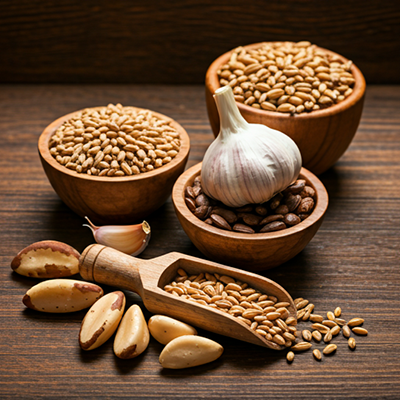Contents
Selenium (Se) is a powerful antioxidant. It works closely with vitamin E and has similar functions. It helps vitamin E accomplish more, so not as much is needed. It keeps hemoglobin from being damaged by oxidation and slows the aging process by inhibiting action of free radicals. Selenium benefits also include the regeneration of liver cells in the case of cirrhosis. It is also essential for the activity of glutathione peroxidase, which is an essential enzyme. It protects the body from mercury, aluminum, lead, and cadmium poisoning. This all-important trace mineral is also involved in thyroid hormone production. In addition, a principal function is to reduce the oxidation of lipids (fatty acids).

Sources
- Nova Scotia dulse
- Norwegian kelp
- Wheat germ
- Brazil nuts
- Brewer’s yeast
- Garlic
- Organically grown foods
- Cereals
- Most vegetables
Primary uses
Primary selenium benefits include cancer prevention, increased immune function, and cardiovascular disease prevention. It helps to treat inflammatory conditions (such as rheumatoid arthritis, eczema, and psoriasis). Selenium benefits also include cataract treatment, ensures proper fetal growth and development (the need for this mineral increases during pregnancy; the levels are always low in low-birth-weight babies). It also lends a hand in the prevention of SIDS (sudden infant death syndrome). Selenium can also help lower blood pressure and improves male fertility.
Deficiency Symptoms
- Muscle degeneration
- Liver damage
- Premature aging
- Heart disturbances
- Muscle weakness
Severe deficiency over a period of time, can induce cancer of the digestive and intestinal tracts. Keshan disease is a severe heart disorder in China in areas where selenium levels in the soil are low. The most common risk of selenium deficiency is an increased risk for cancer, heart disease, and low immune function.

Excessive Intake Symptoms
- Brittle nails
- Garlicky breath
- Hair loss
- Irritability
- Liver and kidney impairment
- Pallor
- Metallic taste in mouth
- Skin eruptions
- Tooth loss
- Yellowish skin
Supplement Forms
Inorganic salts (sodium selenite, etc.) are not absorbed as well and are less active than organic forms (selenomethionine and selenium-rich yeast.)
Interactions
- All other antioxidants work well with selenium in strengthening they system.
Cautions
Selenium absorption and utilization is reduced by heavy metals (mercury, cadmium, lead, etc.), high doses of vitamin C (affects sodium selenite more than organic forms of selenium), high intakes of other trace minerals (especially zinc), and various drugs (especially chemotherapy).
Dosage
RDA not established / ODA 70 mcg / TDA 55 mcg.
- Recommended for selenium benefits: Supplement the diet with 50-200 mcg selenium and 200-400 IU vitamin E. Intake levels above 1000 mcg daily can produce toxicity; so, it is best not to take more than 400 IU daily.
- For children: Take 1.5 mcg per pound of body weight. Do not take more than 40 mcg daily during pregnancy.
HEALTH DISCLAIMER: The information on this website is for educational uses only and is not a substitute for professional medical advice. Always consult an authorized healthcare provider for any health concerns before using any herbal or natural remedy. We do not establish, treat, cure, or prevent any disease. Reliance on any material from this website is solely at your own risk. We are not responsible for any adverse effects resulting from the use of information or products mentioned on this website.
REFERENCES
Vance Ferrell, Harold M. Cherne, M.D. 2010. The Natural Remedies Encyclopedia. Altamont : Harvestime Books, 2010. pp. 114. Vol. Seventh. [Selenium Benefits]
